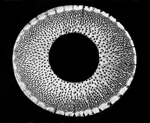
Kansei Period komusō
Wood-cut print in:
'Yamato meisho zu-e', 1791
The National Museum, Denmark
Department of Ethnography
Item no. A 1164, 2
Photographer: John Lee

Bunsei Period komusō
Wood-cut print in:
'Fuji sanjūrokkei', c. 1828
(The Thirty-six Views
of Mount Fuji) by Hokusai

"MYŌ-AN"
The Duality of the Clear
and the Obscure
By Tanikita Muchiku, 1875-1957
|
Chronology
JAPAN 7 • 1767-1883
1767-1883 - The Heyday and Eventual Abolition of the so called "Fuke Sect",
the Return of Shakuhachi Begging, and the Revival of the Kyōto Myōan Temple
一音成仏 - ICHI-ON JŌBUTSU
竹禅一如 - CHIKU-ZEN ICHI-NYO
1768
It is being told that the Edo 'Komusō' Kurosawa Kinko, 1710-1771, travelled all over Japan studying and learning shakuhachi honkyoku pieces which he regarded as representing
the 'true spirit' of the ascetic shakuhachi tradition of his.
In 1768 Kinko was appointed head of the shakuhachi academies, 'fuki-awase', at Reihō-ji and Ichigetsu-ji in Edo.
Founder of the 'Kinko-ryū' of Fuke Shakuhachi, Kurosawa Kinko is believed to have introduced the expressions 'chiku-zen ichi-nyo',
"the oneness of bamboo and Zen", and 'ichi-on jōbutsu', "attaining Buddhahood in a single tone".
However, there exists no documentary evidence for that belief, at all.
The latter expression has its origin in the Zen Buddhist expression
ken-shō jō-butsu',
見性成仏, "Seeing one's original nature - becoming a Buddha", which - acc. to tradition -
was formulated in China by Bodhidharma, the 28th Ch'an/Zen patriarch.

Statue of Kinsen, legendary founder of Ichigetsu-ji
Matsudo City Culture Hall, Tōkyō. Height: 38 cm.
Maker and date unknown
諸国普化宗門寺書上
SHO-KOKU FUKESHŪMON JISHO, JŌ
1777, An'ei 6 (?) - "Book of Fuke Sect Temples in All of Japan", Vol. 1
Or, perhaps rather: dated 1792?
In his excellent 2005 book on shakuhachi history, on page 228, Yamaguchi Masayoshi introduces this particular source of Fuke Shakuhachi history.
Here it is shown how many socalled "Fuke temples" (supposedly) belonged to each of the active branches of the komusō fraternity at this time in history:
金先派 - Kinsen-ha: 16 temples
活総派 - Kassō-ha: 11 temples
梅土派 - Umeji-ha: 9 temples
小菊派 - Kogiku-ha: 10 temples
寄竹派 - Kichiku-ha: 6 temples
根笹派 - Nezasa-ha: 7 temples
不智派 - Fuchi-ha: 8 temples
Total: 67 temples
There is however, reason to be somewhat skeptical regarding the reliability of the date as well as the contents of this information.
I have so far not been able to locate and study any original version of the document.
On the website of 'Komusō' expert Yatō Osamu, he gives the year of publication as 1792, not 1777:
松籟海鳴
1769:
尺八通俗集 - SHAKUHACHI TSŪZOKU-SHŪ
"Popular Shakuhachi Collection" by Oka Shūeki,
岡秀益, dates unknown.

On page 6 in the book, Oka Shūeki introduces the shakuhachi, characterizing the music and practice as 'Buddhist'.
This is the oldest known preserved Japanese publication that presents an actual notated piece of shakuhachi music, but a single of of its kind, though.
xxx
天蓋 - TENGAI
頭書増補訓蒙圖彙大成
1789 - 'Komosō' picture in KASHIRAGAKI ZŌHO KINMŌ ZU-I TAISEI

A shakuhachi player wearing a bee-hive-shaped 'tengai'
In: 'Kashiragaki zōho kinmo zu-i taisei'
('Enlarged Elementary Encyclopedia with Illustrations,
Complete edition'), Kansei 1, 1789, volume 4: "People".
Author: Nakamura Tekisai (1629-1702). Illustrator: Shimokawabe Shūsui.
The first edition, 'Kinmō zu-i', was published in 1666.
I am still searching for copies of this work.
The second edition, 'Kashiragaki kinmō zu-i, appeared in 1695.
To the left of the komusō, the kanji for 'komosō', 'mat monk',
are given. In the text block above, 'komosō' is explained
with the archaic terms of 'boro', 'boronji', and 'kanji'.
The text concludes that a 'komosō' is using the shakuhachi for 'shugyō",
修行,
"ascetic practice" - which is, certainly, not only exclusive to "Zen Buddhist" traditions.
To appreciate the actual original picture, go to this webpage, c/o the National Diet Library, Digital Collection, frame 71 in the online PDF:
1789 komosō illustration

Read more about the encyclopedia here:
www.asiaartsphoenix.com
On this website, unfortunately, the encyclopedia - and the illustration - are, mistakenly, dated 1695:
www.eastern-old-books.com
1791

Woodcut print of a 'komusō' receiving alms
In: 'Yamato meisho zue', "Pictures from Famous Places in Japan".
Text by Akizato Ritō; illustrations
by Takehara Shunchōsai [alt.: Shinkei], 1791
The National Museum of Denmark, Department of Ethnography
Link to the Waseda University Library online archive - go to picture 43:
Woodcut print of a komusō receiving alms, 1791
普化宗門掟書: 諸国普化宗門寺号・
FUKE SHŪMON OKITEGAKI: SHOKOKU FUKE SHŪMON JIGO
"Documents of the Fuke Sect:
List of All the Temples of the Fuke Sect in the Various Provinces"
1792:

List of All the Temples of the Fuke Sect
in the Various Provinces, dated 1792
Matsudo City Museum, Chiba
Source / Link: Yatō Osamu's website
伝導印
DENDŪ-IN
"Permission to Perform Shakuhachi Ascetícism"
1795:

An authorization certificate for a komusō to travel and perform ascetic 'shakuhachi' practices
- a variant of a 'tsū-in', 通印, "Travel Permit".
Issued by the Fukushō-ji (present Saitama Prefecture) in Kansei 7, 1795.
Matsudo City Museum, Chiba
Source / Link: Yatō Osamu's website
The text to the right reads:
十二街道吹尺八
東西南北自由身
In romaji: Jūni-gaidō sui [fuku] shakuhachi, tō-gi-nan-boku jiyū-shin
Literally: "12 roads, blow shakuhachi, East, West, South, North, free body."
Meaning: "[Permission to] blow the shakuhachi everywhere, freely in all directions."
Issued by the Fukushō-ji (present Saitama Prefecture) in Kansei 7, 1795.
虚鐸伝記国字解 - KYOTAKU DENKI KOKUJIKAI
1795 - PUBLICATION of the KYOTAKU DENKI

Komusō in the 'Kyotaku denki kokujikai',
compiled by Yamamoto Morihide, Kyōto, in 1779-80.
This important book was published by Masuya Shōbei of Kōto Shorin,
a Kyōto publishing house, in 1795.

Komusō in the 'Kyotaku denki kokujikai'
Printed in Kurihara Kōta: 'Shakuhachi shikō', 1918/1975.
THE FUKE SECT BRANCHES and THEIR TEMPLES as of 1795:
When publishing the annotated edition of the Kyotaku denki in 1795, the editor, Yamamoto Morihide,
included a complete list of Fuke Sect temples existing at that time:
靳詮派 - Kinzen-ha: 13 temples
活惣派 - Kassō-ha: 10 temples
寄竹派 - Kichiku-ha: 8 temples
小菊派 - Kogiku-ha: 6 temples
小笹派 - Kozasa-ha: 2 temples
梅地派 - Umeji-ha: 13 temples
Total: 52 temples
The 1925 (Taishō 14) edition of Kyotaku denki kokujikai can be studied and appreciated in full at The National Diet Library's website.
Go to frame 13 of the digitalized book to study the complete temple registry:
National Diet Library, Japan: Kyotaku denki kokujikai
普大寺虚無僧本則 - FUDAI-JI KOMUSŌ HONSOKU
1798

Fudai-ji komusō honsoku dated 1798 (Kansei 10)
Iwase Bunko Library, Nishio City, Aichi Prefecture, Japan
Source: Ueno 2002, p. 239
閑田耕筆 - KANDEN KŌHITSU
1799 - KOMOSŌ PICTURE in KŌKEI's KANDEN KŌHITSU

This particular illustration and accompanying text designed and presented by Ban Kōkei,
伴蒿蹊,
1733-1806, in his work 'Kanden Kōhitsu', "Essay on the Cultivation of the Fallow Fields", has created quite some confusion and miscomprehension
in the Western shakuhachi world regarding how a 'Komosō' might have looked like about 500 years ago.
It can not be relied upon as historical evidence. T.O. 2013.
19th CENTURY
京都明暗寺虚無僧本則 - KYŌTO MYŌAN-JI KOMUSŌ HONSOKU
1802: Kyōto Myōan-ji komusō honsoku

Kyōto Myōan-ji komusō honsoku, 1802
Dated in the document itself: Kyōwa 2 (1802), 4th month
Reproduced in Nishiyama, 1975, p. 26
This particular honsoku does present the full text of Chapter 29
in the 'Rinzai-roku' about Fuke Zenji, but not the paragraphs
about the shakuhachi and the tengai
included in the 'Fudai-ji komusō honsoku' dated 1798.
熈代勝覧絵卷 - KIDAI SHŌRAN EMAKI
1805 - "Excellent View of Our Prosperous Age"

Two komusō in the 'Kidai shōran emaki', 1805
By an anonymous artist

A larger view of the 'Kidai shōran emaki', 1805
The two komusō are seen in the lower right corner of the picture

The 'Kidai shōran emaki' on display at the
Museum für Ostasiatiche Kunst, Berlin, 2000
For a full view of the Kidai shōran picture scroll, do visit this webpage:
www.degener.com
1806:

Wood cut print of a 'komusō'
No. 53, 'Kusatsu', in: 'Tōkaidō gojūsan tsugi',
"53 Stations of the Tōkaidō", 1806 edition.
Ukiyo-e print by Katsushika Hokusai, 1760-1849.
一月寺虚無僧本則 - ICHIGETSU-JI KOMUSŌ HONSOKU
1811
Quotation from an Ichigetsu-ji Honsoku dated 1811:
尺八
夫尺八者法器之一也。
謂尺八大數也。
取三節之中定上下之長短。
各有所表。
三節者三才也。
上下之二竅者日月也。
裏表之五竅者五行也。
是萬物之深源也。
吹之則萬物與我融冥而心境之一如也。
- - -
"Shakuhachi
The shakuhachi is an instrument of the Buddhist Law.
The socalled shakuhachi has many numerological meanings to it [lit.: has large numbers].
Taking the distance between the three joints/nodes [respectively] determines the distance [or, length; Jap.: chōtan,
長短] between the top and the bottom.
Every part expresses something.
The upper and lower two openings are the Sun and the Moon.
The five holes on the front and back, respectively, are The Five Elements.
It is The Profound Origin of All Creation.
When one blows [the shakuhachi] then All Myriad Beings cause the Darkness of the Ego to dissolve and the Mind [or, mental state] to become One."
- - -
Excerpt from a komusō 'honsoku' issued by the Fuke Shakuhachi
mother temple Ichigetsu-ji in Matsudo City, Mod. Chiba Pref.,
in 1811, 5th month (Bunka 8). In Kurihara, 1975, pp. 159-162.
Trsl. by Torsten Olafsson, 2013.
1810:
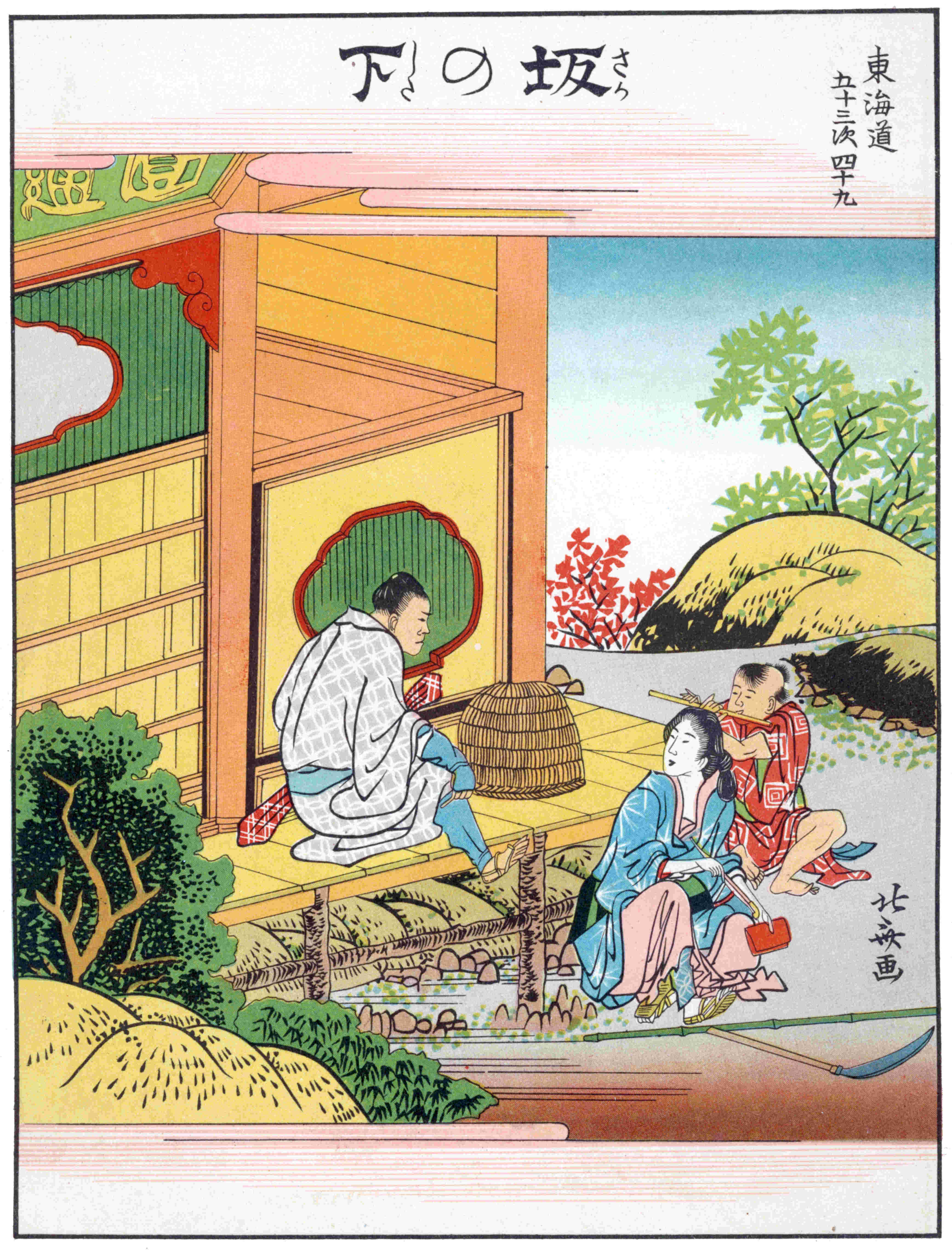
By Katsushika Hokusai, "The 53 Stations of the Tōkaidō", Number 49: 'Sakanoshita'.
This is actually the one and only known image of an Edo Period 'Komusō' pictured as seated relaxed
on a veranda, during a stopover, while his 'tengai' is placed on the veranda, not covering his head
as we otherwise always see in all the numerous published pictures.
一関先生ノ尺八筆記
IKKAN SENSEI's SHAKUHACHI HIKKI
1816 - "Master Ikkan's Notes on the Shakuhachi" by Miyaji Ikkan,
宮地一関, - lived c. 1750-1820?
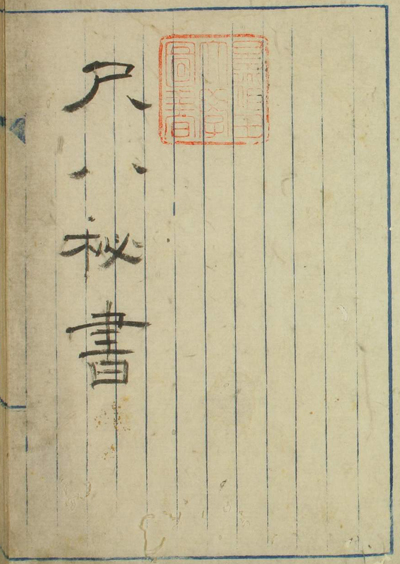
Miyaji Ikkan became a significant figure in the Ichigetsu-ji circles of shakuhachi playing in Edo following upon Kurosawa Kinko's death in 1771.
A complete photographic reproduction of Ikkan Sensei's important literary work Shakuhachi hikki can be studied and appreciated in full at The National Diet Library's website.
In Shakuhachi hikki we also find a complete, annotated komusō "temple" registry, a short text about Hottō Kokushi and his four legendary Chinese Buddhist laymen -
as well as a list of the "old 16 branches" (or, factions) of the komusō semi-religious brotherhood.
You may go to frames 13 through 20 of the digitalized book to study the pages in question yourself:
National Diet Library, Japan: Shakuhachi hikki
Miyaji Ikkan presents his list of komusō temples in relation to their respective branches in a fashion very much like Yamamoto Morihide's in the Kyotaku denki kokujikai:
金先派 - Kinsen-ha: 18 temples
活惣派 - Kassō-ha: 14 temples
梅土派 - Umeji-ha: 9 temples
小菊派 - Kogiku-ha: 10 temples
寄竹派 - Yoritake-ha (Kichiku-ha!): 5 temples
根笹派 - Nezasa-ha: 2 temples
不智派 - Fuchi-ha: 9 temples
Total: 67 temples
Then follows a short text in which Miyaji Ikkan explains how come there came to be [legendarily!] 16 branches of the Fuke Sect:
一書ニ云
後深草院建長六年八月二日法燈国師同船ニテ、
四居士来朝ス。
宝伏居士宋怒居士ハ鎮州ノ人。
国佐居士ハ齋州ノ人。
理正居士ハ幽州ノ人。
又云四居士来朝シテ、興国寺ノ廣化庵ニ住テ、我宗ヲ(?)ム。
四居士各四弟子アリ。
都合十六弟子。
正法ヲ附与ス。
仍テ十六派ニ分ル。
今七派相續九派断絶。
"It says in a book, that during the reign of Emperor Go-Fukakusa, on the 2nd day of the 8th month in the 6th year of the Kenchō Period [1254],
onboard the same ship as Hottō Kokushi there were four Buddhist laymen who came to this country.
The Buddhist laymen Hōfu and Sōjo were men from the Chin Province.
Buddhist layman Kokusa was a man from the Sai Province.
Buddhist layman Risei was a man from the Yū Province.
It also says [in the book] that when the four Buddhist laymen had come to this country they settled to live in the Kōke Hermitage of the Kōkoku Temple,
and then they founded [?] our sect.
The four Buddhist laymen each had four disciples. A total of 16 disciples.
They established the True Teaching [of my/our sect]. Therefore they divided [and organized the sect] into 16 branch sects.
Seven factions have been continued, nine factions have become extinct."
古十六派 - KO-JŪROKU-HA
古十六派ト云ハ - "The old 16 factions were called:
靳詮 改今ノ金先派 - Kinzen, changed to the pres. Kinsen-ha
宋和 今ノ根笹派 - Sōwa - the present Nezasa-ha
火下 今ノ活惣派 - Kaka - the present Kassō-ha
寄竹 - Yoritake/Kichiku
梅土 - Umeji
小菊 - Kogiku
夏潭 今ノ不智派 - Katan - the present Fuchi-ha
右七派相続ス
The above 7 branch sects are continued/are still in existence
養沢 - Yōtaku
義文 大櫻トモ - Gibun - also called Dai-ō [?]
司祖 - Tsukasaso/Shiso
短尺 多門トモ - Tanjaku - also called Tamon
野木 - Noki/Nogi
芝隣 酒林トモ - Shirin - also called Sakabayashi
陰巴 - Indomoe/Inpa
雄南 野ノ派トモ - Yūnan - also called No no ha
児派 - Chigo
右九派断絶ス
The above 9 branch sects are extinct/discontinued"
Trsl. by Torsten Olafsson, 2013.
An almost identical list of 16 branch sects is presented in Koji Ruien Vol. 9, p. 1134:

The headline reads Fuke shūmon okitegaki, 普化宗門掟書
- "Legal Document(s) of the Fuke Sect" [?]
No date is given. I have not yet located a reliable version of the original document.
Here follows a transcript/translation:
火下派 後改活總 - "Kaka-ha - later changed to Kassō
靳詮派 後文字改金先 - Kinzen-ha - later, characters changed to Kinsen
寄竹派 - Kichiku-ha [alt.: Yoritake-ha]
梅土派 - Umeji-ha
夏潭派 後改小菊 - Katan-ha - later changed to Kogiku
司祖派 後改根笹 - Tsukasaso-ha/Shiso-ha - later changed to Nezasa
不智派 - Fuchi-ha
養沢派 在山城國 - Yōtaku-ha - in Yamashiro-guni [present Kyōto-fu]
芝鄰派 在山城國 - Shirin-ha - in Yamashiro-guni [present Kyōto-fu]
義文派 在九州 - Gibun-ha - in Kyūshū
陰巴派 在九州 - Indomoe-ha/Inpa-ha - in Kyūshū
宋和派 在北国 - Sōwa-ha - in Hokkoku [present Nagano & Niigata Prefectures]
雄南派 在石見国 - Yūnan-ha - in Iwami-guni [present Shimane Prefecture]
短尺派 在奥州 - Tanjaku - in Ōshū [Tōhoku Area]
野木派 在尾張国 - Nogi-ha - in Owari-guni [present Aichi Prefecture]
児派 在尾張国 - Chigo-ha - in Owari-guni [present Aichi Prefecture]"
1818
獨言/独言
HITORI-GOTO by HISAMATSU FŪYŌ,
久松 風陽, 1791-1871

Page 1 of the Hitori-goto
Undated, anonymous copy
In: Gutzwiller, 1983
QUOTATIONS from the HITORI-GOTO - "Talking to Myself" / "Monologue"
In German, trsl. from the Japanese by Andreas Gutzwiller:
(1) "Wer shakuhachi lernt, muß for allem weltliche Gedanken verbannen, sich von seinem Begierden trennen und [die Vorstellung] ablegen,
überlegen oder unterlegen zu sein.
Er muß seinen Geist im Bauch konzentrieren, damit er den Ton des Bambus hört. Das ist das wichtigste.
Deswegen muß er mit geschlossenen Augen spielen. Besonders beim Anfänger werden sich weltliche Gedanken einstellen, wenn er die Augen nicht schließt."
(5) "Man darf nicht von Anfang an danach streben, einen schönen Ton zu erlangen, und es ist verdammenswert, wenn jemand es liebt,
einen glanzvollen Ton hervorzubringen."
(8) "Der Anfänger muß zunächst die Technik des shakuhachi Spiels üben. Wenn er die Technik beherrscht, muß er in den Geist der Musik eindringen.
Die Meisterschaft liegt nicht in [der Beherrschung] der Technik sondern im [Eindringen in den] Geist der Musik.
Das Eindringen in den Geist der Musik aber liegt innerhalb der Beherrschung der Technik [des shakuhachi Spiels].
Wer die Technik nicht beherrscht, wird in den Geist der Musik nicht eindringen.
Wer sich als Anfänger um den Geist der Musik kümmert, wird sein Leben lang ein Theoretiker des Bambus-Wegs bleiben. [Daran besteht] keine Zweifel!."
(9) "Es ist sclecht, ständig mit voller kraft wild zu blasen. Man muß gleichmäßig und sicher spielen."
(11) "Es gibt Leute, die glauben, es sei die wahre Bedeutung des Bambus-Tons, 'Trauer um die Vergänglichkeit' trauervoll und mit tiefen Gefühl auszudrücken.
Das ist lächerlich!
Shakuhachi zu spielen, ist in Wirklichkeit nicht dazu da, von anderen gehört zu werden. Shakuhachi ist ein Werkzeug, um seinen Geist zu entwicklen.
Wer sich vom allen gelöst hat, kann dies hören.
Wer [beim Anhören von shakuhachi Musik] Trauer empfindet, wird noch trauriger; wer Freude empfindet, noch freudiger.
Trauer und Freude sind nicht auf Seiten des Spielers, sondern des Hörers. [Daran besteht] keine Zweifel!."
(17) "Es gibt viele, die, wenn sie die Stücke lernen, nur daran denken, die äußere Form auswendig zu lernen. Dies ist im höchsten Grade ein Mißverständnis!
Meri-kari und die richtige Zeit-struktur, dies ist die Essenz [des shakuhachi Spiels], und jemand, der in dieser Erkenntnis spielt, nachdem er die äußere Form gelernt hat,
der ist ein guter Spieler.
Ein Anfänger oder ein Spieler mittleren Grades ist dazu unter keinen Umständen in der Lage. [Für diese] ist das wichtigste, daß sie in allem den Lehrer nachahmen.
Deswegen ist die Wahl des Lehrers von grundlegender Bedeutung. Man darf dabei nicht unvorsichtig vorgehen!
Nur die äußere Form zu spielen, darf nicht 'shakuhachi [spielen]' genannt werden, und hat nichts mit shakuhachi zu tun. Hüte dich ernsthaft davor!"
(21) "So wie ich es [hier] beschrieben habe, ist es für den Anfänger leicht, auf den richtigen Weg zu gelangen,
jedoch waren dies [nur] allgemeine Erklärungen, damit [der Schüler] nicht auf den falschen Weg gerate.
Wie man shakuhachi spielt, muß jeder von seinem Lehrer lernen."
Selected passages from the Hitori-goto by Hisamatsu Fūyō,
1791-1871, written in 1818.
Trsl. by Andreas Gutzwiller, 1983, p. 164-168.
19th CENTURY - Travelling komusō in the Art of Ukiyo-e:

Wood-block print by Katsushika Hokusai, ca. 1828

Wood-block print by Andō Hiroshige, 1833

Wood-block print by Utagawa Kuniyoshi, 1834

Wood-block print by Saitō Yukio, his son and/or his grand son, ca. 1835

Wood-block print by Andō Hiroshige (lived 1797-1858)

Wood-block print by Andō Hiroshige or Ikeda Eisen (lived 1790-1848)

Wood-block print by Ikeda Eisen, 1833
1826? (1800-1829):
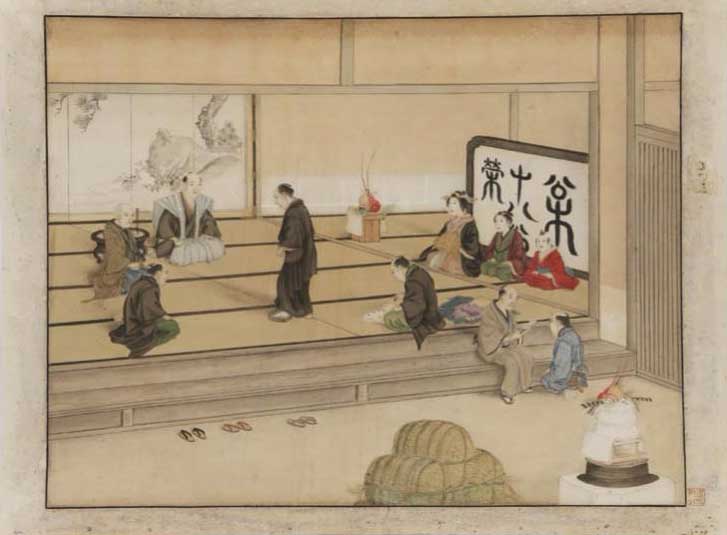
Painting of a 'fumi-e' inquisitional ceremony by Kawahara Kaiga, 1786-1860, created sometime during 1800-1829.
Source: National Library of the Netherlands. Link:
geheugenvannederland.nl
一休話し - IKKYŪ-BANASHI
Mid-19th CENTURY: TALE ABOUT IKKYŪ SŌJUN
"DIALOGUE WITH A YAMABUSHI -
One time when Ikkyū was in a solitary mood, he went to the Kantō with only his flute for company.
A yamabushi happened to meet this priest strolling up the path playing his flute like a wandering komusō.
Feigning stupidity, the yamabushi approached and asked him,
'I say there, wandering priest, where are you going?'
'I go wherever the wind takes me.'
'I see. But what do you do when the wind stops blowing?'
'Why I just do the blowing myself,' said Ikkyū turning back to his flute.
Outdone, the yamabushi clapped his mouth shut and passed by without a backward glance."
In the Ikkyū zu-e shūi by Tsujimoto Motosada, mid-19th century.
Trsl. by James H. Sanford, 1981.
James H. Sanford's epilogue in his book 'Zen-man Ikkyū', 1981:
"Without a backward glance, Ikkyū has passed us by. The real
Ikkyū, the historical Ikkyū, is long gone, disappeared into his tomb
at Takagi.
The Ikkyū who wrote the 'Kyōun-shū' is virtually entombed too -
within the difficult idiom of classical Chinese where he lies unread by
all but a few scholars.
Ikkyū the calligrapher-painter survives, of course, though only in
fragments and half-hidden among a host of forged semblances.
Ikkyū the prose writer who should, linguistically at least, be fairly
accessible to his modern countrymen is almost unknown as well.
The best known Ikkyū, the Ikkyū of the Tokugawa tales, never really
lived at all, and now he too has ambled over the hill, leaving behind
only the far, distant notes of his flute.
The greatest masters foster no schools.
They imitate themselves until the matter is ended."
普化僧之儀ニ付け御觸 - FUKE-SŌ no GI ni TSUKE GO-SHOKU
"Proclamation Regarding the Fuke Monk Affair"
1848, Friday January 21
(Kōka 4, 12th month, 26th day)
The Fuke "Sect" is placed under the direct jurisdiction of the Rinzai Sect of Buddhism

The government proclamation of January 21st, 1848
In Yamaguchi, 2005, p. 161
The komusō fraternity is (eventually) put under the direct administration and supposed control of the Rinzai Sect of Japanese Zen Buddhism.
The date of this very important official government document is normally given as 1847, Kōka 4.
However, the date of the 26th day in the 12th month of Kōka 4 did not fall late in 1847,
but is equivalent with January the 21st, 1848, a Friday, according to the Western, Gregorian calendar!
You can verify this fact, yourself, via this very useful calendrical calculator:
yukikurete.de/nengo_calc.htm
According to Kiku Day, Denmark:
" - - - The relationship between the bakufu [the Edo government] and the Fuke sect
worsened, due to difficulties controlling the sect and criminal behaviour on the
part of some monks.
In 1847 a decree from the government stated that the Fuke
sect was subject to the same rules as the Rinzai sect. This revoked the special
privileges granted in Keichō no Okitegaki, which led to frustration among the
komusō monks. The deterioration in the relationship culminated when GENDŌ
Kanmyō, the thirty-third kansu of Myōanji, and MYŌAN Sugyō, also from
Myōanji, were involved in the 'Hamaguri Gomon Rebellion'
[蛤御門の変 ],
in 1864, as advocates for Imperial rule against the Tokugawa Shogunate. Mutual distrust
increased, as did the number of sanctions and investigations of komusō monks. - - - "
Link: Kiku Day article, Cambridge University Press
According to WikiPedia, Germany:
" - - - 1847 wurde die Fuke-shū als eigenständige Schule aufgelöst und ihre Anhänger rechtmäßig der Rinzai-shū unterstellt. - - - "
Link: WikiPedia, Germany: Fuke-shū
According to Stan Richardson, USA:
" - - - In 1847 the Shogun Tokugawa Ideyoshi, after struggling to bring the Fuke-shu under his control, finally abolished the 1614 edict.
He disenfranchised the Fuke-shu and allowed all classes of people to become Komuso. - - - "
Link: Webpage: Ichi-on jobutsu
According to Gunnar Jinmei Linder, thesis p. 130:
" - - - Kurihara remarks that the abuse and mischief of the komusō continued,
and the authorities eventually issued a proclamation that in effect disclaimed the privilegies that the
"Keichō okite-gaki" had brought with it.
In 1847, the central authorities issued an official proclamation to the monks of the Fuke sect, in which it is stated that their activities had
become disorderly and indecent in recent years, that the denomination was a branch of
Rinzai Zen and that the monks should follow the path of a Zen Buddhist monk. It also states
that the sect should not make claims of being a hiding place, but rather that they should
conduct their activities in the same way as monks of other denominations, and receive what
people bestow on them, i.e., not extort alms, receive money for honsoku licenses, or other
worldly activities. - - - "
Link: Gunnar Jinmei Linder doctoral thesis
According to Riley Kelly Lee, thesis ch. 3:
" - - - All of the effort to maintain the official recognition and status of the sect was to be of no avail.
There finally came a time when the benefits to the bakufu were far outweighed by the disadvantages of allowing the Fuke sect to retain its special privileges.
In 1847, the government issued a furegaki (触書, circulated official announcements, frequently posted on public announcement boards throughout the country),
unequivocally stating that the privileges of the Fuke sect,
as stated in the Keichō no okitegaki, were no longer valid and should have never been granted in the first place. The announcement revoked the rule that only those of samurai birth could join the sect.
Since the Fuke sect was under the auspices of the Rinzai sect of Zen Buddhism, which anyone could join regardless of birth, it was argued by the bakufu that the same criteria for membership should apply to the Fuke sect.
Furthermore, the announcement stated that the members of the sect did not require special privileges to exercise their spiritual practices, but they did need to cultivate charity of the heart (Kamisango 1974:18). - - - "
Link: Riley Kelly Lee doctoral thesis
1850s?

Edo Period picture of the komusō's Ichigetsu Temple in the Chiba Pref. Matsudo City Museum Komusō Room.
Photo by Ronald Nelson, The International Shakuhachi Society, 2014.
Acc. to the information given below right, this wood-cut print was published in the illustrated magazine titled
Fūzoku gahō,
風俗画報,
"Human Customs Illustrated News Magazine",
No. 279, most probably dated towards the close of the 19th century.
1853 - THE ARRIVAL of COMMODORE PERRY in JAPAN
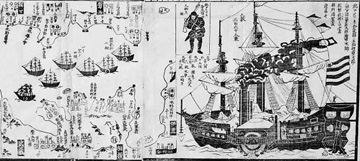
Admiral Perry's second fleet in Japan, 1854
Japanese print, 1854 - artist unknown
July 8, 1853: US admiral Matthew Calbraith Perry, 1794-1858, arrives with a small fleet in the Tōkyō Bay commissioned to negotiate a US trade treaty with Japan.
Perry threatens the city of Uraga with the ships' powerful guns and the Japanese authorities (the shōgunate) agree to receive a letter of request from US President Millard Fillmore.
Returning with twice as many ships in February, 1854, on March 31, Perry finally succeeds in having signed a friendship treaty between The United States of America and Japan.
1860s? - THE LAST DAYS of the KOMUSŌ

Ichigetsu-ji komusō - late Tokugawa Period
Photograph in the collection of the Matsudo City Culture Hall, Tōkyō
Name of photographer unknown. In: Kikan hōgaku 5, 1975
In 1853-1854, Eliphalet Brown, Jr., 1816-1886, Commodore Perry's
official photographer, was the first to take pictures of Japan
and its people, using the daguerreotype technnique.
Since then, the art of photography soon became
widespread throughout the country.
普化宗
の
廃止 - FUKE-SHŪ no HAISHI
1871, Thursday November 30th - THE PROHIBITION of the FUKE SECT
(Meiji 4, 10th month, 18th day)
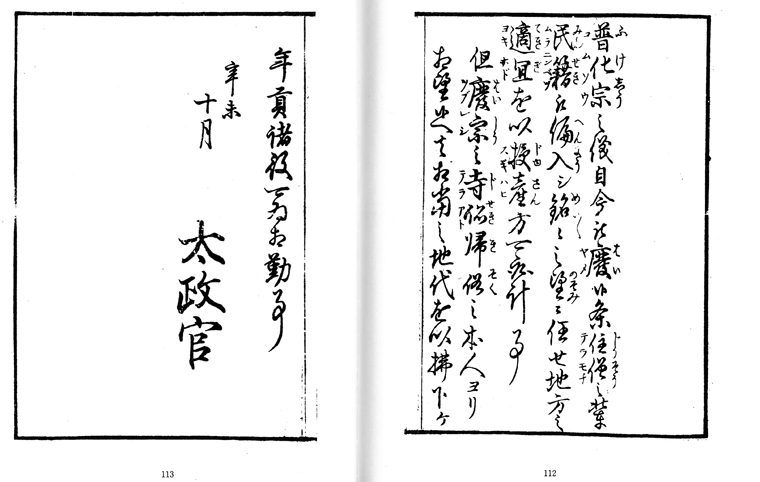
明治4年10月18日大政官布告第558号
- - -
普化宗之儀字自今被廃候各住職僧の輩民籍江編人銘々の望に仕せ地方の適宣を以て授産方可取計事。
但廃宗の寺路帰俗本人より相望候得共相当の地在を以て払下げ年貢諸役可為相勤候也。
辛未10月
大政官
- - -
Edict No. 558 issued by the Meiji Government's Grand Council of State (Daijōkan) on November 30, 1871 (Meiji 4):
"(According) to the article on the abolishing of the rules of the Fuke-shū,
(effective) from today, monastic officials and monks (ju-sō 住[職]僧)
are to be restored into the status of citizens (minseki 民籍),
to be transferred to the fixed conditions and it should be arranged that they enter professions appropriate to the region.
The temples left after the abolishing of the order (haishū 廃宗), however, be sold for an appropriate price,
a duty and auxiliary service to their original inhabitants after they have returned to laïty (kizoku 歸俗).
Shinmatsu 辛末, 10th month, Daijōkan 太政官."
Trsl. by Max Deeg, 2007, p. 33, note 86.
Edict text digitized by Iida Kyorei:
Iida Kyorei: Fukeshū no haishi.
See also Ueno Katami, 2002, p. 234.
Read more about Haibutsu kishaku, 廃仏毀釈, or "throw away the Buddha, abolish the monks"), during the early Meiji Period here:
Wikipedia: Haibutsu kishaku.
旧明暗寺 - KYŪ MYŌAN-JI
1873 - The KYŌTO MYŌAN-JI MAIN GATE is DISASSEMLBED and MOVED
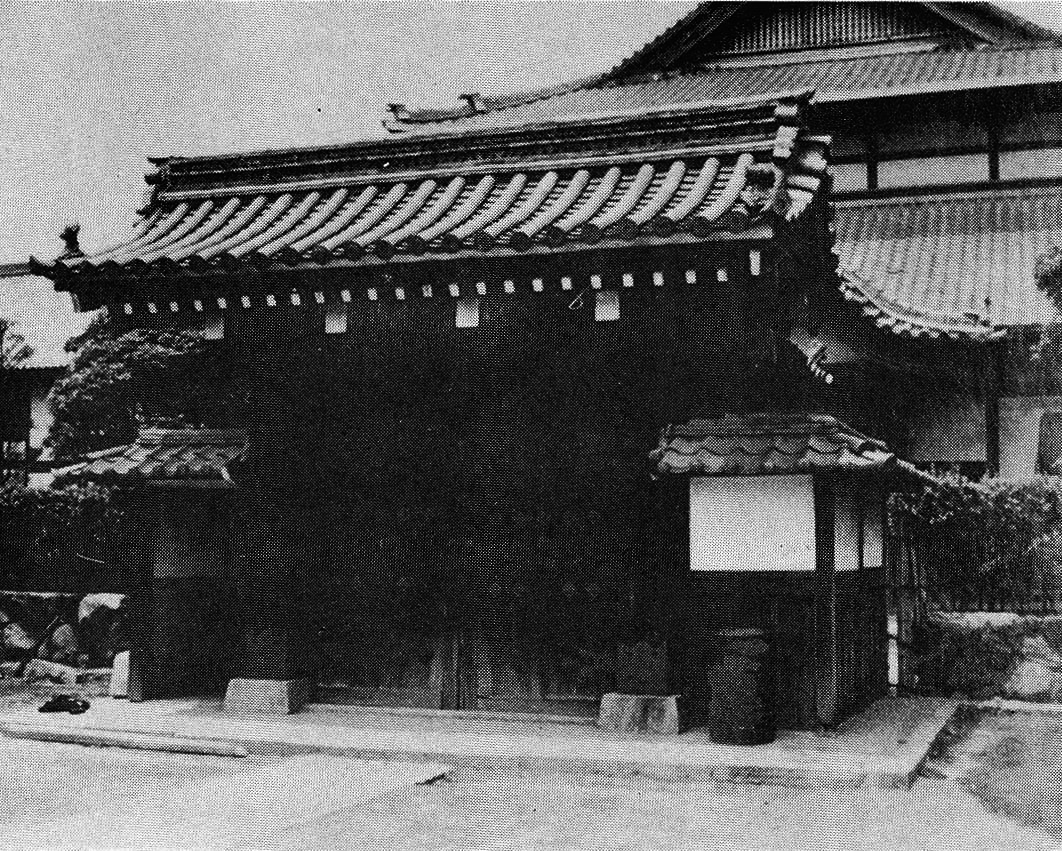
Gate of the former, late Edo Period, Myōan-ji at Kitashirakawa Shimo-Ikeda-chō in Eastern Kyōto
Photo in: Tomimori, 1979
THE MOVE
With the abolition of the so called "Fuke Sect" in late November, 1871 (Meiji 4),
all of its "temples" and haunts were ordered to be closed, the premises be sold off, while 'Komusō' mendicancy was prohibited.
Acc. to Kanagawa resident shakuhachi player Maekawa Kōgetsu,
前川耕月, updating his weblog in late April, 2018, the old Myōan-ji main gate
was disassembled and first moved to an elementary school in central Kyōto to be reassembled there.
Now, the old, worn Myōan-ji gate can be seen and appreciated within the precincts of the Yūzū Nenbutsu sect's mother temple Dainenbutsu-ji,
大念仏寺, in Hirano-ku, Ōsaka:


The old Myōan-ji gate reinstalled at Dainenbutsu-ji in Hirano-ku, Ōsaka. Photos: T.O., March 13, 2019
At some time later, Myōan-ji's precious statue of its legendary founder Kyochiku Ryōen Zenji was, allegedly,
together with various especially important Myōan-ji documents, entrusted to the Zen'e-in,
善慧院,
a small subtemple of the grand Tōfuku-ji Zen temple in SE Kyōto.
It is, however, alsso possible that the treasured Myōan-ji belongings were rather first installed at the Zen'e-in in 1950.

Statue of Kyochiku Ryōen Zenji - legendary "founder"
in the main hall of present-day Kyōto Myōan-ji
Source (website): Myōan Shakuhachi to Sapporo Dōjō
1876:
黄檗派
から
黄檗宗
へ
FROM 'ŌBAKU-HA' to 'ŌBAKU-SHŪ'
- from "The Ōbaku Branch of Rinzai Zen" to "The Ōbaku Sect of Zen"!
In 1661, the Japanese Government, the Bakufu and the Temples & Shrines Magistrates, granted a new branch of Zen Buddhism introduced earlier in the century to establish permanent headquarters,
the Manpuku Temple, on legally granted and acquired land in the town of Uji, south of Kyōto.
The Imperial family had also been in wholehearted support of the monks of this alternative Ōbaku Line of Chinese Ch'an/Zen.
Still, the Ōbaku group certainly did not acquire full status as a genuine Buddhist sect in its own right, but remained but a "branch", a ha,
派,
being administered by the central Rinzai Zen temple authorities in Kyōto - until its eventual approval as late as in 1876 in a new capacity as a fully indpendent and self-administering Zen sect,
existing till today as the quite unique Ōbaku Sect (of Zen).
In contrast, the so called "Fuke Sect" movement of the komusō never experienced anything like the above at all,
and it was fairly easy for the new, radical and pretty consequent Meiji Government to ban, dissolve and eradicate
whatever was left by the time of November 30, 1871 of the then anyhow quite loosely connected network and local centers of the komusō brotherhood in Japan.
However, fortunate and almost miraculous as that is:
The komusō certainly did not live and die in vain: Their ascetic bamboo flute music has survived until this very day,
now flourishing both in and outside of Japan.
A very important book about Ōbaku Zen and Manpuku-ji in Japan:
Helen Josephine Baroni: Ōbaku Zen. The Emergence of the Third
Sect of Zen in Tokugawa Japan.
University of Hawai'i Press, Honolulu, 2000.
|
|
